steering wheel RENAULT TWINGO 2012 2.G Owners Manual
[x] Cancel search | Manufacturer: RENAULT, Model Year: 2012, Model line: TWINGO, Model: RENAULT TWINGO 2012 2.GPages: 220, PDF Size: 6.73 MB
Page 7 of 220
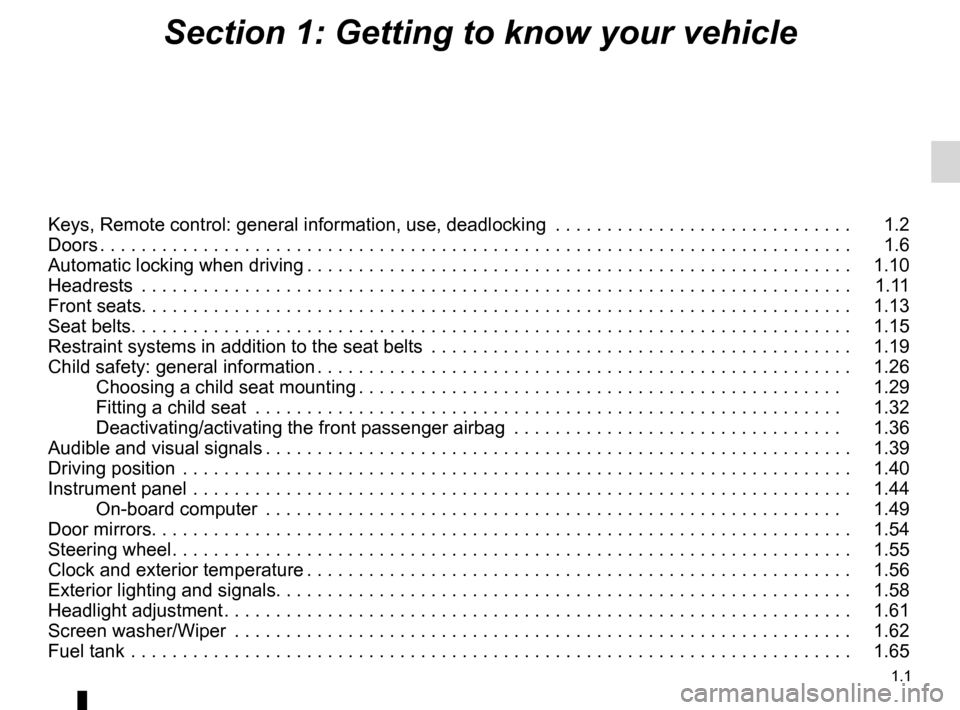
1.1
ENG_UD30793_17
Sommaire 1 (X44 - Renault)
ENG_NU_952-4_X44_Renault_1
Section 1: Getting to know your vehicle
Keys, Remote control: general information, use, deadlocking . . . . . . . . . . . . . . . . . . . . . . . . . . . . . 1.2
Doors . . . . . . . . . . . . . . . . . . . . . . . . . . . . . . . . . . . . . . . . . . . . . . . . . . . . . . . . . . . . . . . . . . . . . . . . . 1.6
Automatic locking when driving . . . . . . . . . . . . . . . . . . . . . . . . . . . . . . . . . . . . . . . . . . . . . . . . . . . . . 1.10
Headrests . . . . . . . . . . . . . . . . . . . . . . . . . . . . . . . . . . . . . . . . . . . . . . . . . . . . . . . . . . . . . . . . . . . . . 1.11
Front seats . . . . . . . . . . . . . . . . . . . . . . . . . . . . . . . . . . . . \
. . . . . . . . . . . . . . . . . . . . . . . . . . . . . . . . . 1.13
Seat belts . . . . . . . . . . . . . . . . . . . . . . . . . . . . . . . . . . . . \
. . . . . . . . . . . . . . . . . . . . . . . . . . . . . . . . . . 1.15
Restraint systems in addition to the seat belts . . . . . . . . . . . . . . . . . . . . . . . . . . . . . . . . . . . . . . . . . 1.19
Child safety: general information . . . . . . . . . . . . . . . . . . . . . . . . . . . . . . . . . . . . . . . . . . . . . . . . . . . . 1.26
Choosing a child seat mounting . . . . . . . . . . . . . . . . . . . . . . . . . . . . . . . . . . . . . . . . . . . . . . . 1.29
Fitting a child seat . . . . . . . . . . . . . . . . . . . . . . . . . . . . . . . . . . . . . . . . . . . . . . . . . . . . . . . . . 1.32
Deactivating/activating the front passenger airbag . . . . . . . . . . . . . . . . . . . . . . . . . . . . . . . . 1.36
Audible and visual signals . . . . . . . . . . . . . . . . . . . . . . . . . . . . . . . . . . . . . . . . . . . . . . . . . . . . . . . . . 1.39
Driving position . . . . . . . . . . . . . . . . . . . . . . . . . . . . . . . . . . . . . . . . . . . . . . . . . . . . . . . . . . . . . . . . . 1.40
Instrument panel . . . . . . . . . . . . . . . . . . . . . . . . . . . . . . . . . . . . . . . . . . . . . . . . . . . . . . . . . . . . . . . . 1.44
On-board computer . . . . . . . . . . . . . . . . . . . . . . . . . . . . . . . . . . . . . . . . . . . . . . . . . . . . . . . . 1.49
Door mirrors . . . . . . . . . . . . . . . . . . . . . . . . . . . . . . . . . . . . . . . . . . . . . . . . . . . . . . . . . . . . . . . . . . . . 1.54
Steering wheel . . . . . . . . . . . . . . . . . . . . . . . . . . . . . . . . . . . . . . . . . . . . . . . . . . . . . . . . . . . . . . . . . . 1.55
Clock and exterior temperature . . . . . . . . . . . . . . . . . . . . . . . . . . . . . . . . . . . . . . . . . . . . . . . . . . . . . 1.56
Exterior lighting and signals . . . . . . . . . . . . . . . . . . . . . . . . . . . . . . . . . . . . \
. . . . . . . . . . . . . . . . . . . . 1.58
Headlight adjustment . . . . . . . . . . . . . . . . . . . . . . . . . . . . . . . . . . . . . . . . . . . . . . . . . . . . . . . . . . . . . 1.61
Screen washer/Wiper . . . . . . . . . . . . . . . . . . . . . . . . . . . . . . . . . . . . . . . . . . . . . . . . . . . . . . . . . . . . 1.62
Fuel tank . . . . . . . . . . . . . . . . . . . . . . . . . . . . . . . . . . . . . . . . . . . . . . . . . . . . . . . . . . . . . . . . . . . . . . 1.65
Page 21 of 220
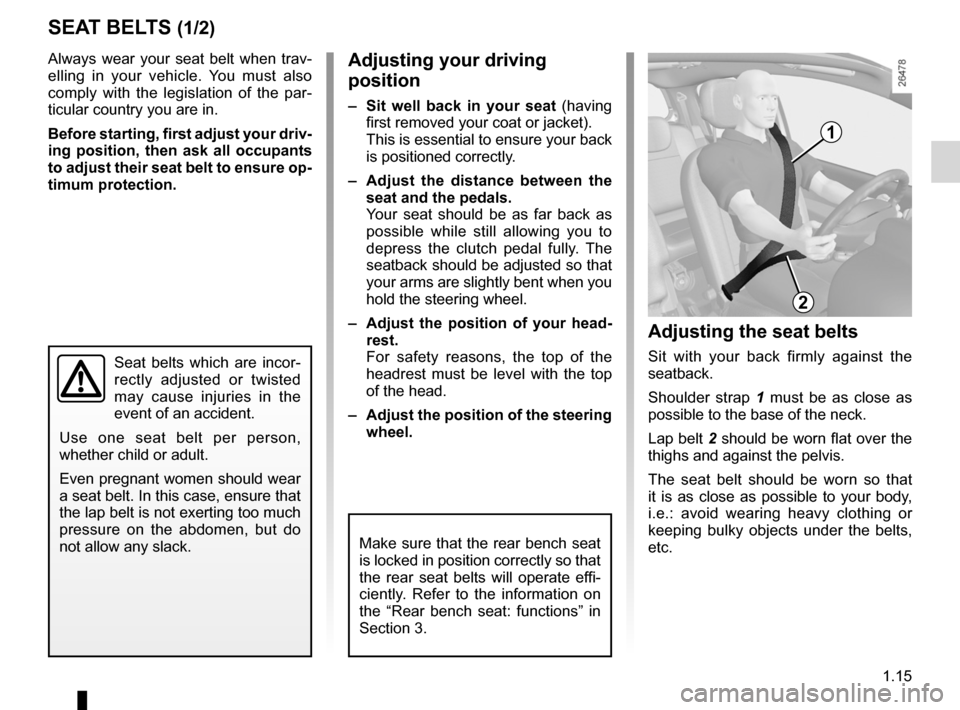
seat belts .............................................. (up to the end of the DU)
adjusting your driving position .............. (up to the end of the DU)
1.15
ENG_UD30822_6
Ceintures de sécurité (X44 - Renault)
ENG_NU_952-4_X44_Renault_1
Seat belts
sEAT BELTs (1/2)
Always wear your seat belt when trav-
elling in your vehicle. You must also
comply with the legislation of the par -
ticular country you are in.
Before starting, first adjust your driv-
ing position, then ask all occupants
to adjust their seat belt to ensure op-
timum protection.Adjusting your driving
position
– s it well back in your seat (having
first removed your coat or jacket).
This is essential to ensure your back
is positioned correctly.
– Adjust the distance between the
seat and the pedals.
Your seat should be as far back as
possible while still allowing you to
depress the clutch pedal fully. The
seatback should be adjusted so that
your arms are slightly bent when you
hold the steering wheel.
– Adjust the position of your head-
rest.
For safety reasons, the top of the
headrest must be level with the top
of the head.
– Adjust the position of the steering
wheel.
Adjusting the seat belts
Sit with your back firmly against the
seatback.
Shoulder strap 1 must be as close as
possible to the base of the neck.
Lap belt 2 should be worn flat over the
thighs and against the pelvis.
The seat belt should be worn so that
it is as close as possible to your body,
i.e.: avoid wearing heavy clothing or
keeping bulky objects under the belts,
etc.
Make sure that the rear bench seat
is locked in position correctly so that
the rear seat belts will operate effi -
ciently. Refer to the information on
the “Rear bench seat: functions” in
Section 3.
Seat belts which are incor -
rectly adjusted or twisted
may cause injuries in the
event of an accident.
Use one seat belt per person,
whether child or adult.
Even pregnant women should wear
a seat belt. In this case, ensure that
the lap belt is not exerting too much
pressure on the abdomen, but do
not allow any slack.
1
2
Page 26 of 220
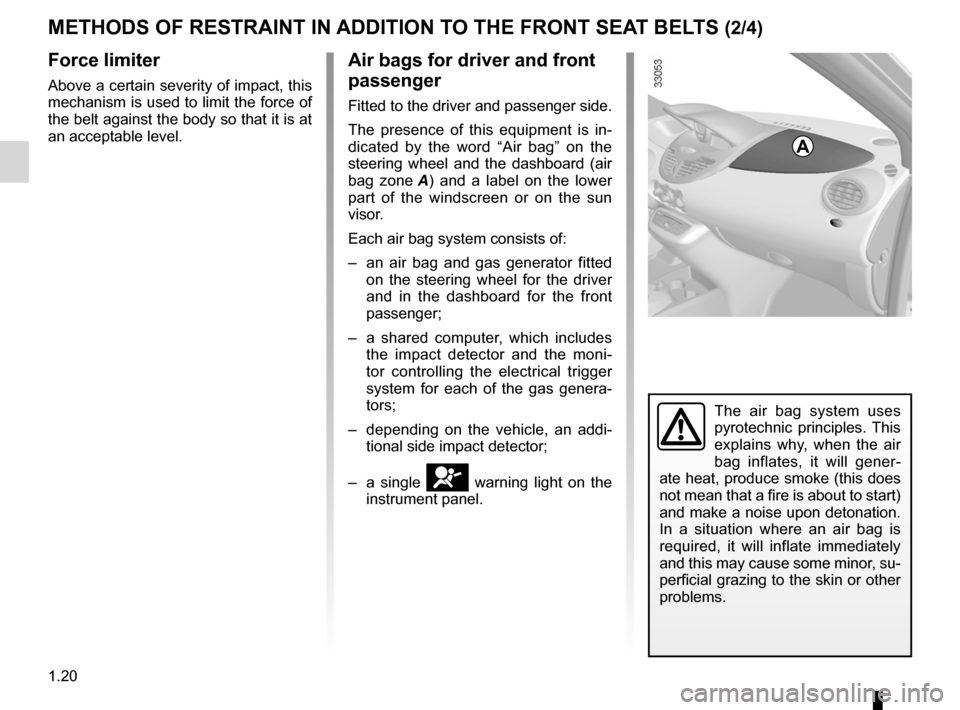
1.20
ENG_UD24708_5
Dispositifs complémentaires à la ceinture avant (X44 - Renault)
ENG_NU_952-4_X44_Renault_1
Jaune NoirNoir texte
METhODs OF REsTRAINT IN ADDITION TO ThE FRONT sEAT BELTs (2/4)
Force limiter
Above a certain severity of impact, this
mechanism is used to limit the force of
the belt against the body so that it is at
an acceptable level.
Air bags for driver and front
passenger
Fitted to the driver and passenger side.
The presence of this equipment is in -
dicated by the word “Air bag” on the
steering wheel and the dashboard (air
bag zone A ) and a label on the lower
part of the windscreen or on the sun
visor.
Each air bag system consists of:
– an air bag and gas generator fitted
on the steering wheel for the driver
and in the dashboard for the front
passenger;
– a shared computer, which includes
the impact detector and the moni -
tor controlling the electrical trigger
system for each of the gas genera -
tors;
– depending on the vehicle, an addi -
tional side impact detector;
– a single
å warning light on the
instrument panel.
The air bag system uses
pyrotechnic principles. This
explains why, when the air
bag inflates, it will gener -
ate heat, produce smoke (this does
not mean that a fire is about to start)
and make a noise upon detonation.
In a situation where an air bag is
required, it will inflate immediately
and this may cause some minor, su-
perficial grazing to the skin or other
problems.
A
Page 27 of 220
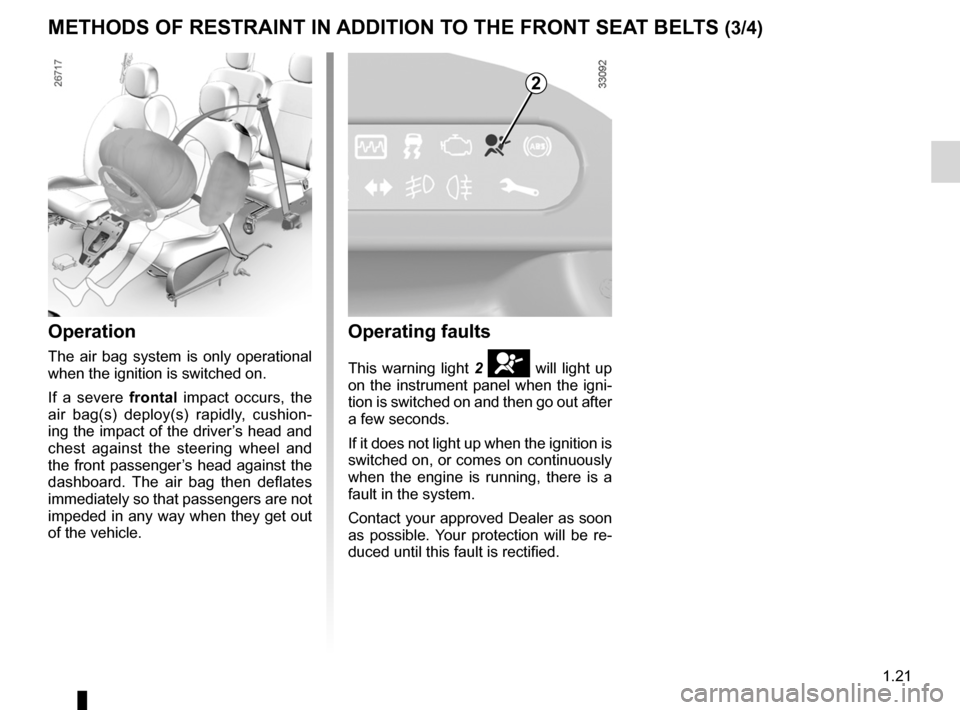
JauneNoirNoir texte
1.21
ENG_UD24708_5
Dispositifs complémentaires à la ceinture avant (X44 - Renault)
ENG_NU_952-4_X44_Renault_1
METhODs OF REsTRAINT IN ADDITION TO ThE FRONT sEAT BELTs (3/4)
Operation
The air bag system is only operational
when the ignition is switched on.
If a severe frontal impact occurs, the
air bag(s) deploy(s) rapidly, cushion -
ing the impact of the driver’s head and
chest against the steering wheel and
the front passenger’s head against the
dashboard. The air bag then deflates
immediately so that passengers are not
impeded in any way when they get out
of the vehicle.
Operating faults
This warning light 2 å will light up
on the instrument panel when the igni -
tion is switched on and then go out after
a few seconds.
If it does not light up when the ignition is
switched on, or comes on continuously
when the engine is running, there is a
fault in the system.
Contact your approved Dealer as soon
as possible. Your protection will be re-
duced until this fault is rectified.
2
Page 28 of 220

1.22
ENG_UD24708_5
Dispositifs complémentaires à la ceinture avant (X44 - Renault)
ENG_NU_952-4_X44_Renault_1
METhODs OF REsTRAINT IN ADDITION TO ThE FRONT sEAT BELTs (4/4)
All of the warnings below are given so that the air bag is not obstructed in any way when it is deployed and also to pre-
vent the risk of serious injuries caused by items which may be dislodged\
when the air bag deploys.
Warnings concerning the driver’s air bag
– Do not modify the steering wheel or the steering wheel boss.
– Do not cover the steering wheel boss under any circumstances.
– Do not attach any objects (badge, logo, clock, telephone holder, etc.) to the steering wheel boss.
– The steering wheel must not be removed (except by qualified personnel from our Network).
– When driving, do not sit too close to the steering wheel. Sit with your arms slightly bent (see the information on “Adjusting
your driving position” in Section 1). This will allow sufficient space for the air bag to deploy correctly and be fully effective.
Warnings concerning the passenger air bag
– Do not attach or glue any objects (badge, logo, clock, telephone holder, etc.) to the dashboard on or near the air bag.
– Do not place anything between the dashboard and the passenger (pet, umbrella, walking stick, parcels, etc.).
– The passenger must not put his or her feet on the dashboard or seat as there is a risk that serious injuries may occur. In
general, parts of the body should be kept away from the dashboard (knee\
s, hands, head, etc.).
– The systems in addition to the front passenger seat belt should be reactivated as soon as a child seat is removed, to ensure
the protection of the passenger in the event of an impact.
A REAR-FACING ChILD sEAT MUsT NOT BE FITTED TO ThE FRONT p AssENGER sEAT UNLEss
ThE ADDITIONAL REsTRAINT sYsTEMs, I.E. ThE p AssENGER AIR BAG, ARE DEACTIVATED.
(Refer to Section 1 “Child safety: deactivating/activating the front\
passenger air bag”).
Page 45 of 220
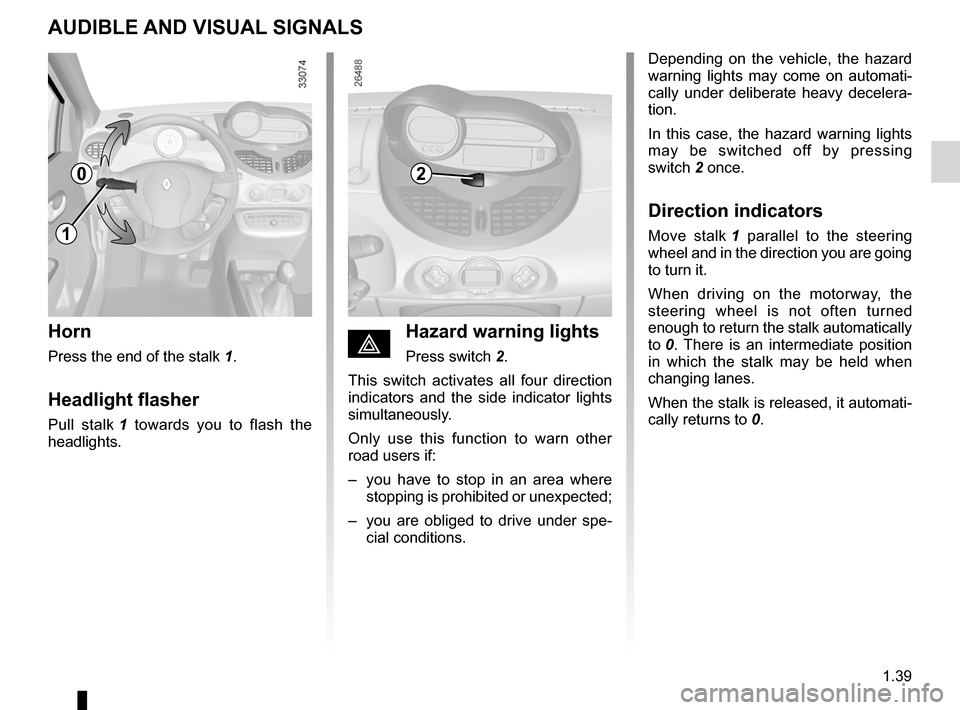
audible and visual signals......................................(current page)
hazard warning lights signal .................................. (current page)
lights: direction indicators ........................................... (current page)
lights: hazard warning ................................................ (current page)
hazard warning lights signal .................................. (current page)
1.39
ENG_UD24710_3
Avertisseurs sonores et lumineux (X44 - Renault)
ENG_NU_952-4_X44_Renault_1
Audible and visual signals
AUDIBLE AND VIsUAL sIGNALs
horn
Press the end of the stalk 1.
headlight flasher
Pull stalk 1 towards you to flash the
headlights.
éhazard warning lights
Press switch 2.
This switch activates all four direction
indicators and the side indicator lights
simultaneously.
Only use this function to warn other
road users if:
– you have to stop in an area where
stopping is prohibited or unexpected;
– you are obliged to drive under spe -
cial conditions. Depending on the vehicle, the hazard
warning lights may come on automati
-
cally under deliberate heavy decelera -
tion.
In this case, the hazard warning lights
may be switched off by pressing
switch 2 once.
Direction indicators
Move stalk 1 parallel to the steering
wheel and in the direction you are going
to turn it.
When driving on the motorway, the
steering wheel is not often turned
enough to return the stalk automatically
to 0 . There is an intermediate position
in which the stalk may be held when
changing lanes.
When the stalk is released, it automati-
cally returns to 0.
0
1
2
Page 47 of 220
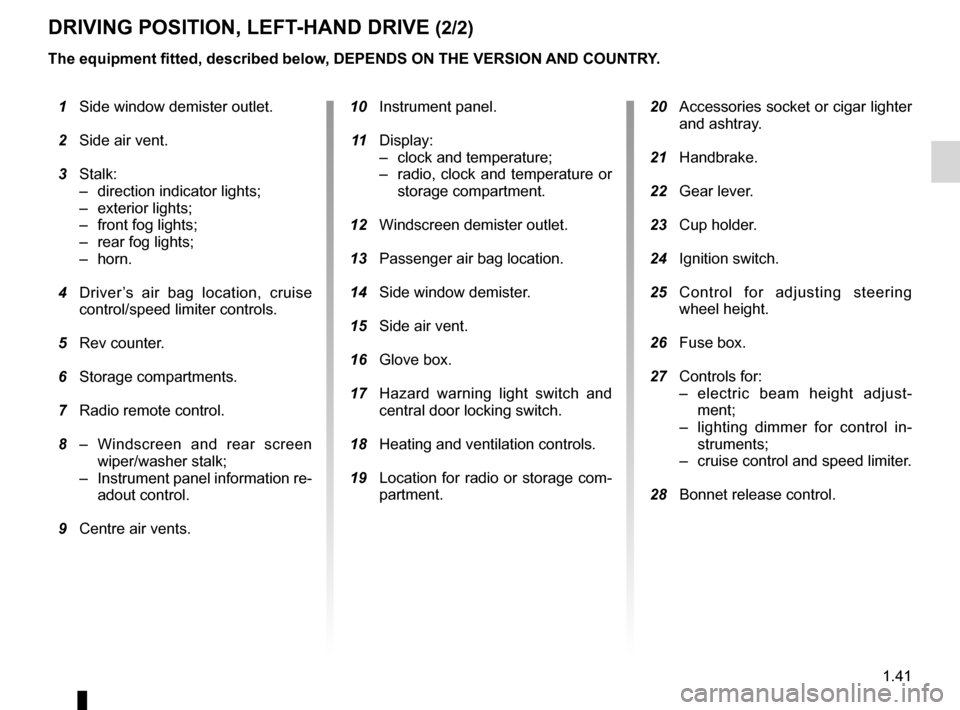
JauneNoirNoir texte
1.41
ENG_UD24711_5
Poste de conduite direction à gauche (X44 - Renault)
ENG_NU_952-4_X44_Renault_1
DRIVING pOsITION, LEFT-hAND DRIVE (2/2)
1 Side window demister outlet.
2 Side air vent.
3 Stalk:
– direction indicator lights;
– exterior lights;
– front fog lights;
– rear fog lights;
– horn.
4 Driver ’s air bag location, cruise
control/speed limiter controls.
5 Rev counter.
6 Storage compartments.
7 Radio remote control.
8 – Windscreen and rear screen
wiper/washer stalk;
– Instrument panel information re-
adout control.
9 Centre air vents.
10 Instrument panel.
11 Display:
– clock and temperature;
– radio, clock and temperature or
storage compartment.
12 Windscreen demister outlet.
13 Passenger air bag location.
14 Side window demister.
15 Side air vent.
16 Glove box.
17 Hazard warning light switch and
central door locking switch.
18 Heating and ventilation controls.
19 Location for radio or storage com-
partment.
20 Accessories socket or cigar lighter
and ashtray.
21 Handbrake.
22 Gear lever.
23 Cup holder.
24 Ignition switch.
25 Control for adjusting steering
wheel height.
26 Fuse box.
27 Controls for:
– electric beam height adjust -
ment;
– lighting dimmer for control in -
struments;
– cruise control and speed limiter.
28 Bonnet release control.
The equipment fitted, described below, DEpENDs ON ThE VERsION AND COUNTRY.
Page 49 of 220
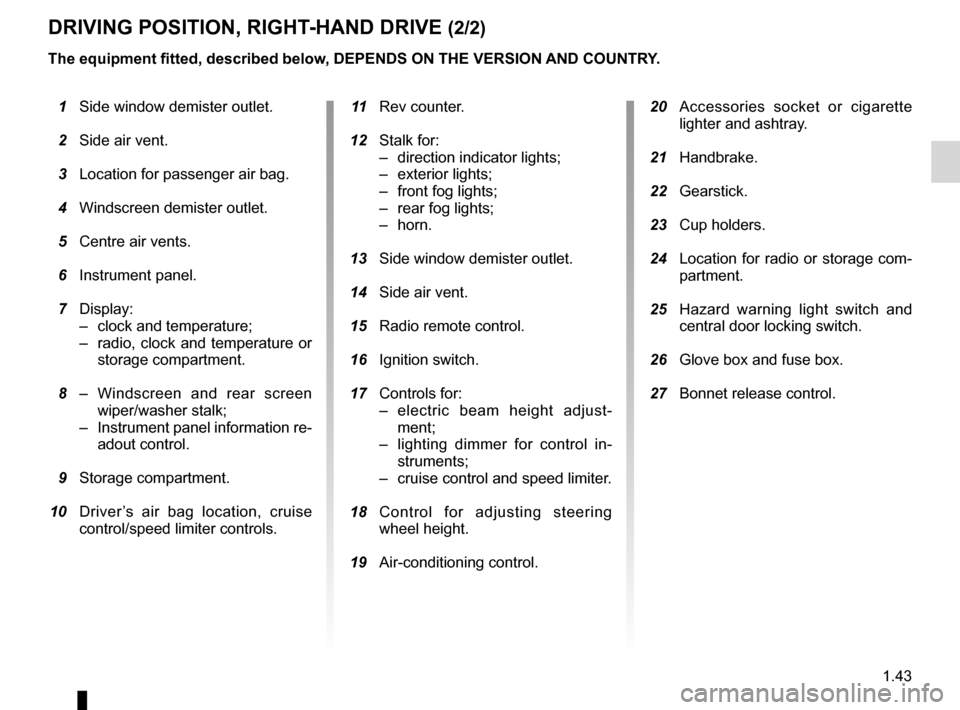
JauneNoirNoir texte
1.43
ENG_UD24749_3
Poste de conduite direction à droite (X44 - Renault)
ENG_NU_952-4_X44_Renault_1
DRIVING pOsITION, RIGhT-hAND DRIVE (2/2)
1 Side window demister outlet.
2 Side air vent.
3 Location for passenger air bag.
4 Windscreen demister outlet.
5 Centre air vents.
6 Instrument panel.
7 Display:
– clock and temperature;
– radio, clock and temperature or
storage compartment.
8 – Windscreen and rear screen
wiper/washer stalk;
– Instrument panel information re-
adout control.
9 Storage compartment.
10 Driver ’s air bag location, cruise
control/speed limiter controls.
11 Rev counter.
12 Stalk for:
– direction indicator lights;
– exterior lights;
– front fog lights;
– rear fog lights;
– horn.
13 Side window demister outlet.
14 Side air vent.
15 Radio remote control.
16 Ignition switch.
17 Controls for:
– electric beam height adjust -
ment;
– lighting dimmer for control in -
struments;
– cruise control and speed limiter.
18 Control for adjusting steering
wheel height.
19 Air-conditioning control. 20 Accessories socket or cigarette
lighter and ashtray.
21 Handbrake.
22 Gearstick.
23 Cup holders.
24 Location for radio or storage com-
partment.
25 Hazard warning light switch and
central door locking switch.
26 Glove box and fuse box.
27 Bonnet release control.
The equipment fitted, described below, DEpENDs ON ThE VERsION AND COUNTRY.
Page 61 of 220
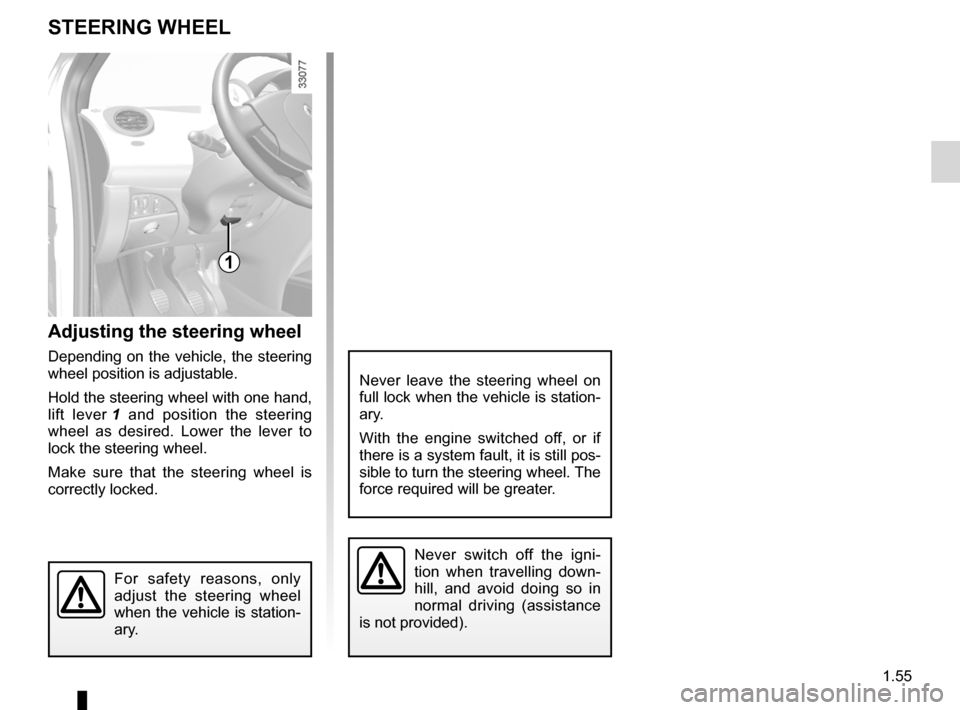
steering wheeladjustment ....................................................... (current page)
1.55
ENG_UD24726_4
Volant de direction (X44 - Renault)
ENG_NU_952-4_X44_Renault_1
Steering wheel
sTEERING WhEEL
Adjusting the steering wheel
Depending on the vehicle, the steering
wheel position is adjustable.
Hold the steering wheel with one hand,
lift lever 1 and position the steering
wheel as desired. Lower the lever to
lock the steering wheel.
Make sure that the steering wheel is
correctly locked.
For safety reasons, only
adjust the steering wheel
when the vehicle is station-
ary.
Never leave the steering wheel on
full lock when the vehicle is station-
ary.
With the engine switched off, or if
there is a system fault, it is still pos-
sible to turn the steering wheel. The
force required will be greater.
Never switch off the igni -
tion when travelling down -
hill, and avoid doing so in
normal driving (assistance
is not provided).
1
Page 74 of 220
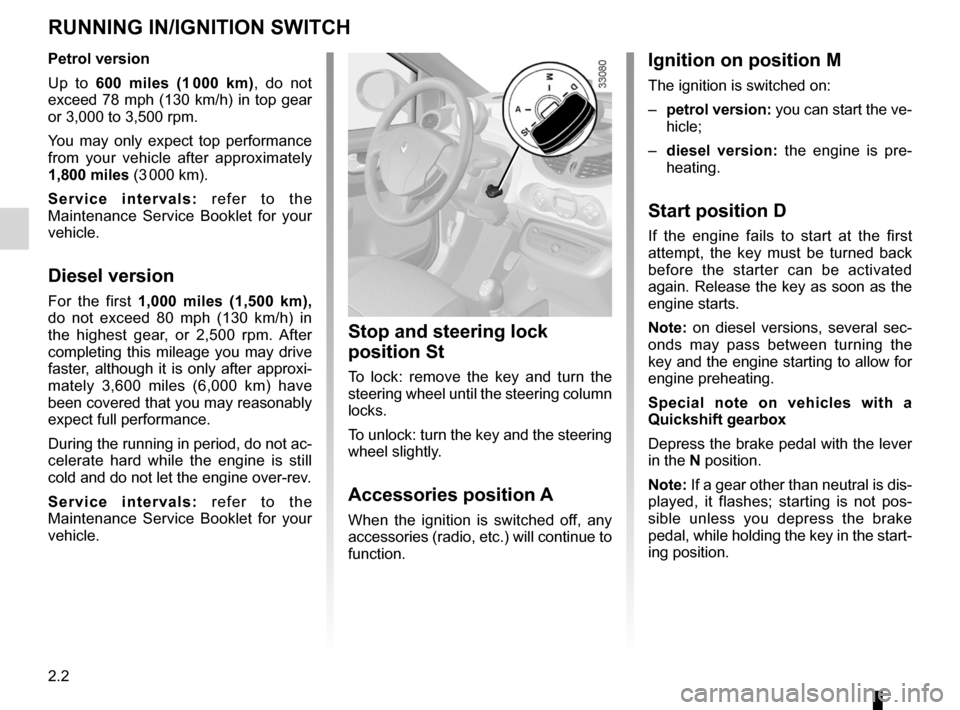
engine immobiliser (switch) .................. (up to the end of the DU)
ignition switch ....................................... (up to the end of the DU)
starting the engine ................................ (up to the end of the DU)
running in .............................................. (up to the end of the DU)
driving ................................................... (up to the end of the DU)
2.2
ENG_UD30504_4
Rodage (X44 - Renault)
ENG_NU_952-4_X44_Renault_2
Running in - Ignition switch
Petrol version
Up to 600 miles (1 000 km) , do not
exceed 78 mph (130 km/h) in top gear
or 3,000 to 3,500 rpm.
You may only expect top performance
from your vehicle after approximately
1,800 miles (3 000 km).
S e r v i c e i n t e r v a l s : r e f e r t o t h e
Maintenance Service Booklet for your
vehicle.
Diesel version
For the first 1,000 miles (1,500 km),
do not exceed 80 mph (130 km/h) in
the highest gear, or 2,500 rpm. After
completing this mileage you may drive
faster, although it is only after approxi -
mately 3,600 miles (6,000 km) have
been covered that you may reasonably
expect full performance.
During the running in period, do not ac-
celerate hard while the engine is still
cold and do not let the engine over-rev.
S e r v i c e i n t e r v a l s : r e f e r t o t h e
Maintenance Service Booklet for your
vehicle.
RUNNING IN/IGNItIoN SwItch
Stop and steering lock
position St
To lock: remove the key and turn the
steering wheel until the steering column
locks.
To unlock: turn the key and the steering
wheel slightly.
Accessories position A
When the ignition is switched off, any
accessories (radio, etc.) will continue to
function.
Ignition on position M
The ignition is switched on:
– petrol version: you can start the ve-
hicle;
– diesel version: the engine is pre -
heating.
Start position D
If the engine fails to start at the first
attempt, the key must be turned back
before the starter can be activated
again. Release the key as soon as the
engine starts.
Note: on diesel versions, several sec -
onds may pass between turning the
key and the engine starting to allow for
engine preheating.
Special note on vehicles with a
Quickshift gearbox
Depress the brake pedal with the lever
in the N position.
Note: If a gear other than neutral is dis-
played, it flashes; starting is not pos -
sible unless you depress the brake
pedal, while holding the key in the start-
ing position.